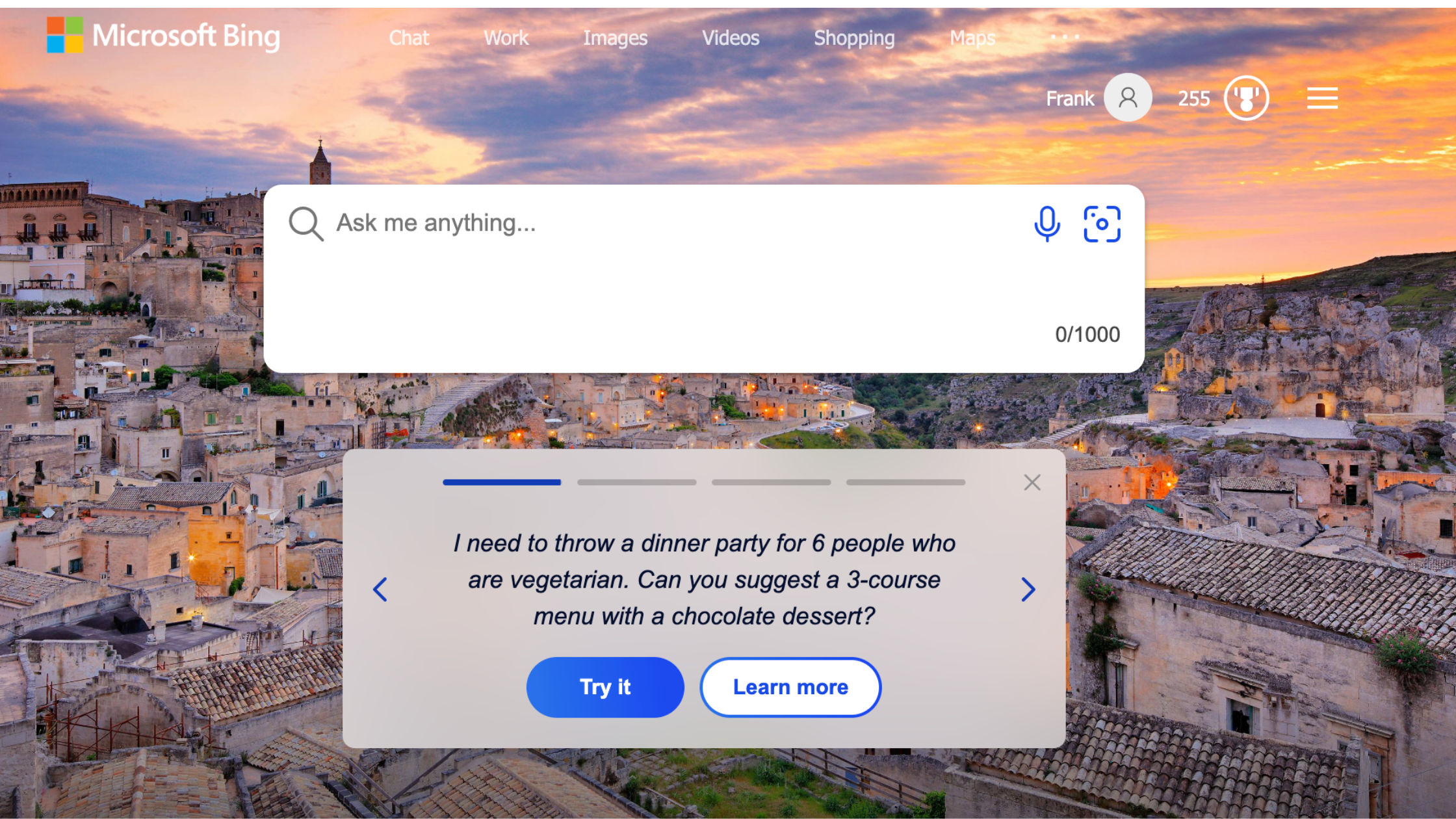The new Bing is now powered by OpenAI’s GPT-4 technology, which has been customized for search. This means that Bing can now carry on a conversation with users and understand queries written in natural language. At time of writing, the only way to access the new Bing with ChatGPT functionality via a web browser is to open it in Microsoft’s Edge browser.
This could be the beginning of a new era of searching the web, one in which you tell your search engine what you want in a far more natural and intuitive way.
Table of Contents

Bing Chat GPT Shift Keywords to Conversational Queries
As the new Bing integrates ChatGPT powered by OpenAI’s GPT-4 technology, the way users interact with the search engine is transforming. This shift from traditional keyword-based searches to conversational queries will have significant implications for the advertising landscape.
Bing’s Understanding User Intent
Conversational queries allow Bing to better understand user intent, as they provide more context and information. Advertisers will need to adapt their keyword strategies and focus on long-tail keywords that represent natural language phrases. This will enable them to target ads more effectively, based on the context and intent of a user’s query.
Bing’s Semantic Search and Advertising
With the transition to conversational queries, Bing’s semantic search capabilities will become more crucial. Advertisers must ensure their content and ads are semantically relevant to users’ queries. This will involve a deeper understanding of the language and context, allowing ads to be more accurately matched with user intent.
Evolving Keyword Research Techniques for Bing
Keyword research will need to evolve in response to the rise of conversational queries. Advertisers must shift their focus towards natural language phrases, questions, and statements that users are likely to use when engaging with Bing ChatGPT. This will require new approaches to keyword research that account for variations in phrasing, colloquialisms, and regional language differences.
Enhanced Ad Copy and Landing Pages
As users engage in more conversational searches, ad copy and landing pages must also adapt. Advertisers should create copy that reflects natural language, mimics the conversational tone of users, and addresses their specific questions or concerns. Landing pages must also be optimized to provide immediate answers and relevant information to users who arrive through conversational queries.
Monitoring and Adapting to User Behavior
The shift to conversational queries will require advertisers to closely monitor user behavior and adjust their strategies accordingly. By analyzing conversational data, advertisers can gain valuable insights into user intent, preferences, and pain points, allowing them to refine their ad targeting and messaging for improved performance.
Personalization in Advertising through AI-Powered Insights (Bing ChatGPT)
The integration of ChatGPT-4 technology into Bing’s search engine presents new opportunities for advertisers to create more personalized and targeted ad experiences. AI-powered insights can help advertisers better understand their audiences and tailor their ads to meet individual needs and preferences.
Enhanced Audience Segmentation
AI-powered insights enable advertisers to create more refined audience segments based on user behavior, interests, and demographics. By leveraging this data, advertisers can develop tailored ad campaigns that resonate with specific target groups, leading to higher engagement and conversion rates.
Contextual Relevance
AI-driven algorithms can analyze the context of a user’s search query or browsing history to serve ads that are more relevant to their interests and needs. By understanding the intent behind a user’s search, advertisers can create ads that are more likely to resonate with the user and drive engagement.
Impact of Voice-Activated Searches on Ad Targeting (Bing Chat GPT)
As voice-activated searches become increasingly popular with the integration of Bing ChatGPT and other AI-driven voice assistants, advertisers must adapt their strategies to accommodate this shift in user behavior. The rise of voice search presents both challenges and opportunities for ad targeting.
Longer and More Conversational Queries
Voice searches tend to be longer and more conversational than traditional text-based queries. This means advertisers must adapt their keyword strategies to include long-tail keywords and natural language phrases that better match the way users speak.
Understanding User Intent
With voice-activated searches, users are more likely to ask questions or make requests, providing more context and information about their intent. Advertisers must analyze these queries to understand user needs and preferences, allowing them to create ads that align with user intent and provide relevant solutions.
Local and Hyperlocal Advertising
Voice searches often involve queries related to local businesses, services, or events. Advertisers must capitalize on this trend by optimizing their ads for local and hyperlocal targeting, ensuring their ads are displayed to users in their target geographical areas.
The Importance of Mobile Optimization
Voice searches are predominantly conducted on mobile devices, making it essential for advertisers to optimize their ads and landing pages for mobile users. Mobile-friendly ad formats and responsive landing pages can help enhance the user experience and increase the likelihood of conversions.
Adapting to New Ad Formats
As voice search gains popularity, new ad formats tailored to voice interactions are likely to emerge. Advertisers must stay up to date with these developments and be prepared to adapt their strategies to incorporate voice-based ad formats and interactions.
The Importance of Product Feeds in the Age of Conversational Search
As conversational search gains prominence, product feeds play a crucial role in ensuring that advertisers provide accurate and up-to-date information for users. Optimizing product feeds helps advertisers capitalize on the shift from keywords to conversational queries, voice-activated searches, and AI-powered personalization.
Optimizing Product Feeds for Conversational Queries
To stay relevant in the era of conversational search, advertisers must optimize their product feeds to include long-tail keywords and natural language phrases that users are likely to use when engaging with Bing ChatGPT. This will help improve ad relevance and visibility in response to conversational queries.
Leveraging AI-Powered Insights for Feed Optimization
Advertisers can utilize AI-powered insights to optimize their product feeds, ensuring they stay up-to-date and relevant to users’ preferences and behavior. By analyzing product data, advertisers can make data-driven decisions about product feed updates, pricing, and inventory management.
Feed Optimization for Voice-Activated Searches
Optimizing product feeds for voice-activated searches is essential to remain competitive in the changing search landscape. Advertisers must adapt their keyword strategies to accommodate the unique characteristics of voice search and ensure their product feeds align with user expectations.
Structuring Product Feeds for Voice Search
To maximize the effectiveness of product feeds in voice-activated searches, advertisers must ensure their feeds are structured in a way that is easily understood by voice search algorithms. This includes using clear and descriptive product titles, incorporating conversational phrases, and providing comprehensive product information.
Enhancing Local Product Feed Optimization
With the prevalence of local queries in voice searches, advertisers must optimize their product feeds for local and hyperlocal targeting. This includes providing accurate store locations, up-to-date inventory data, and region-specific offers to ensure users receive the most relevant information during voice-activated searches.
In conclusion, product feeds and feed optimization are essential aspects of advertising success in the age of conversational search and voice-activated searches. By optimizing product feeds for conversational queries and voice search, leveraging AI-powered insights, and focusing on local optimization, advertisers can stay ahead in the rapidly evolving digital advertising landscape.


